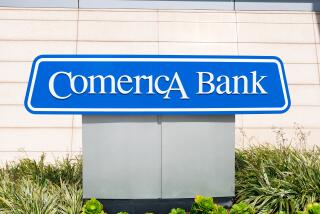COLUMN LEFT : Crackdown Is Stemming Credit Flow : Banks are now under intense scrutiny and small businesses are feeling the pressure.
- Share via
Many small businesses are being harmed by something that supposedly no longer happens: a credit crunch caused by a wave of banking failures.
The crunch is most severe in the Northeast, which is on the brink of a regional recession, and in the South, which absorbed more than its share of bank and thrift collapses.
Evidently, the regulators in charge of banking standards are not the same regulators responsible for making sure that sound businesses can get credit. The Federal Reserve sets monetary policy nationally. But banks fail regionally. And though the Federal Reserve is organized by region, the 12 regional Federal Reserve banks don’t operate independent credit policies.
Before 1913, when the Federal Reserve was created, banking panics regularly led to loans being called and a sharp contraction of the supply of credit. Perfectly sound businesses went under because they couldn’t roll over their loans.
The creation of a central banking system was hailed as the solution to the problem. But in the Great Depression, despite the Federal Reserve, loan defaults and runs on banks pushed thousands of banks into insolvency. The solution to that problem was federal deposit insurance, invented in 1933. Together, a central bank and the Federal Deposit Insurance Corporation supposedly relegated credit crunches to the history books.
Today, however, the old dilemma of credit crunch is beginning to reappear. And this time, ironically, the federal banking agencies may be part of the problem.
In the early 1980s, President Reagan’s bank regulators jumped on the deregulation bandwagon. Federally insured banks were permitted to engage in all sorts of speculative transactions. After insured lenders piled up hundreds of billions of dollars in losses, the chastened regulators finally cracked down on the banks--as well they should.
But many small businesses find themselves caught in the middle. In Massachusetts, surveys show that 150 healthy manufacturing firms are having difficulty rolling over normal operating loans.
Commercial and industrial loan volume grew at a robust 17% in 1985, 24% in 1986, 8% in 1987, and turned negative in 1989. Consumer loans also shrank by 12% last year, after several years of high growth. Real-estate loans grew by an astounding 42% in 1985, 51% in 1986, and 32% in 1987. They barely grew at all in 1989 and actually began to shrink last winter.
It is normal for credit to shrink somewhat in a recession. In the case of real estate, the problem isn’t mainly higher bank standards but overbuilding in the mid-1980s. When unsold condos and unrented offices pile up, developers stop building--not for lack of credit but for lack of customers.
But there is also evidence that a credit crunch is beginning to contribute to the economic distress of ordinary businesses. Several of the large banks of the Northeast and Southeast have had to sell off or write off loans in order to satisfy bank regulators.
When loans go bad, a bank finds itself with too many loans on its books relative to the bank’s own capital. The bank examiners demand that shaky banks either raise additional capital (which is usually impossible) or get rid of some loans in order to restore a prudent ratio of capital to loans.
In the Northeast, the largest regional banks have just come through a searing going-over by teams of bank examiners. The same intense scrutiny is now being applied to the banks of the Southeast.
In such times, loan officers pull in their horns. They don’t want any more trouble occurring on their watch. Banks feel under pressure to improve the quality of their loan portfolios.
Blue-chip bank customers make out fine, but many small businesses with good credit ratings complain that they suddenly can’t get credit. In a financial squeeze, banks find that it costs almost as much to make a $20,000 loan as a $20-million loan--and the small loan isn’t worth the trouble.
It is understandable that the first priority of the bank examiners is to limit further drains on taxpayer-supported deposit insurance. But somehow, they have to reconcile that goal with the goal of keeping credit flowing.
When Wall Street went into cardiac arrest in October, 1987, the Federal Reserve ordered the money spigots turned wide open to keep the financial crash from becoming a full-blown recession. If the Fed did that for Wall Street, it should do no less for Main Street.
More to Read
Inside the business of entertainment
The Wide Shot brings you news, analysis and insights on everything from streaming wars to production — and what it all means for the future.
You may occasionally receive promotional content from the Los Angeles Times.










